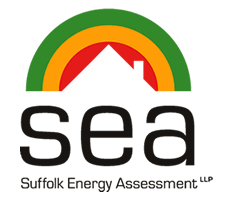The energy sector takes efficiency very seriously; indeed, even when just discussing it, industry representatives will thriftily foreshorten bulky technical terms into a mere smattering of letters. Here, following, are a few of the acronyms and abbreviations you may encounter on your path to energy-efficient living and working
| ABBE |
 Awarding Body for the Built Environment; issues nationally recognised qualifications that qualify practitioners to undertake assessments of the energy efficiency and carbon emissions of dwellings and commercial buildings; SEA's accredited energy assessor holds ABBE qualifications in both domestic and non-domestic energy assessment; see www.abbeqa.co.uk |
| BRE | Building Research Establishment; developer of SBEM approved software (see below) and part of the BRE Trust, a registered charity; see www.bretrust.org.uk |
| BREEAM | BRE Environmental Assessment Method; see www.breeam.org |
| BRUKL | Building Regulation UK Part L; Part L (fuel and energy conservation) of the Building Regulations 2000 sets maximum carbon dioxide emissions for whole buildings; see www.planningportal.gov.uk |
| CCL | Climate Change Levy, first announced in the Budget 1999; see http://customs.hmrc.gov.uk, www.carbontrust.co.uk, www.decc.gov.uk |
| CEA | Commercial Energy Assessor; CEAs produce EPCs (listed below) for commercial and industrial premises in England and Wales; see www.communities.gov.uk, for further information, and www.ndepcregister.com, which lists accredited assessors |
| CIBSE | Chartered Institution of Building Services Engineers (of which our assessor is a student affiliate); see www.cibse.org |
| CLG | Department of Communities and Local Government; see www.communities.gov.uk |
| CO2 | carbon dioxide; EPCs are part of Europe-wide measures reflecting legislation that will help cut buildings' CO2 emissions; 'Act on CO2' (see www.direct.gov.uk/actonCO2) is a UK Government initiative that helps individuals understand and reduce their carbon footprint; the Carbon Trust (see www.carbontrust.co.uk) aims to accelerate the move to a low carbon economy by working with organisations to reduce carbon emissions and develop commercial low carbon technologies |
| CRed | carbon reduction; CRed Suffolk Climate Change Partnership (or CRed Suffolk) comprises all the local authorities in Suffolk and key partner organisations working together to promote low carbon initiatives and adaptation to a changing climate; see www.cred-uk.org/suffolk |
| CSH | Code for Sustainable Homes; also known as 'the Code', it is a standard for the design and construction of sustainable homes that measures nine categories, including energy, water, and waste; see www.communities.gov.uk |
| DEA | Domestic Energy Assessor; accredited assessors are listed on www.communities.gov.uk and www.hcrregister.com; SEA's energy assessor's accreditation number is NHER001644 |
| DECC | Department of Energy and Climate Change; see www.decc.gov.uk |
| ECAs | Enhanced Capital Allowances; see www.carbontrust.co.uk |
| EPBD | Directive 2002/91/EC of the European Parliament and of the Council of 16 December 2002 on the energy performance of buildings; see the Official Journal of the European Communities, 4.1.2003, L 1/65 (available as a PDF from http://eur-lex.europa.eu/JOIndex.do?ihmlang=en) and also www.communities.gov.uk/epbd |
| EPC | energy performance certificate; EPCs must be produced using the relevant calculation tool specified in the National Calculation Methodology; see www.communities.gov.uk and http://campaigns.direct.gov.uk/epc |
| IMechE | Institution of Mechanical Engineers (of which our assessor is an affiliate member); see www.imeche.org |
| NDEPC | non-domestic energy performance certificate (also known as a 'commercial EPC' or a 'non-dwelling EPC'); see www.nher.co.uk for further, general information and www.ndepcregister.com for a list of accredited assessors (SEA's energy assessor's accreditation number is NHER001644) |
| NEF | National Energy Foundation, the independent charity promoting energy conservation and providing help to improve energy efficiency in residential buildings; NES (see below) is a trading subsidiary of the charity; see www.nef.org.uk |
| NES | National Energy Services; an approved accreditation body for energy assessors for non-dwellings; owns and operates NHER and SAVA (see below); provides government-approved accreditation of energy assessors, including SEA's accredited energy assessor, Miles Anstes (NHER accreditation number NHER001644); see www.nesltd.co.uk |
| NHER | National Home Energy Rating, the UK's first and largest energy rating system; SEA's accredited energy assessor undertook his DEA and CEA (see above) training through NHER; see www.nher.co.uk and, to search for accredited energy assessors, www.epcregister.com (our assessor's accreditation number is NHER001644) |
| RCEP | Royal Commission on Environmental Pollution; see www.rcep.org.uk |
| RdSAP | reduced data standard assessment procedure (see SAP, below) used in the collection of information to appear on EPCs issued for existing dwellings; RdSAP comprises a standard set of data items and a standard way of inferring the missing data where a full SAP assessment is not carried out |
| RICS | Royal Institution of Chartered Surveyors (of which our assessor is a student member); see www.rics.org |
| ROs | Renewables Obligation; see www.carbontrust.co.uk and www.berr.gov.uk |
| RRN | every EPC is identified by a 24-digit report reference number (RRN), assigned uniquely to it/the assessed property; an assessed property's RRN appears on the front page of its EPC; the number may also be referred to as a 'unique reference number' (URN) |
| SAP | standard assessment procedure; adopted by the government as the national methodology for calculating the energy performance of buildings; used to demonstrate compliance with Part L of the Building Regulations 2000 and to provide energy ratings |
| SAVA | Surveyors and Valuers Accreditation; sister company to NHER (listed above); see www.sava.org.uk |
| SBEM | Simplified Building Energy Model; software developed for the UK Government by BRE, SBEM analyses a building's energy consumption; the SBEM tool is designed to assess buildings that are not dwellings and is used to demonstrate compliance for dwellings with Part L of the Building Regulations 2000 |
| SCAP | Suffolk Climate Action Plan; see www.greensuffolk.org |
| S.I. 2007/991 | The Energy Performance of Buildings (Certificates and Inspections) (England and Wales) Regulations 2007 – also referred to as 'Statutory Instruments 2007 No. 991'; see www.opsi.gov.uk/si/si2007/uksi_20070991_en_1 |

